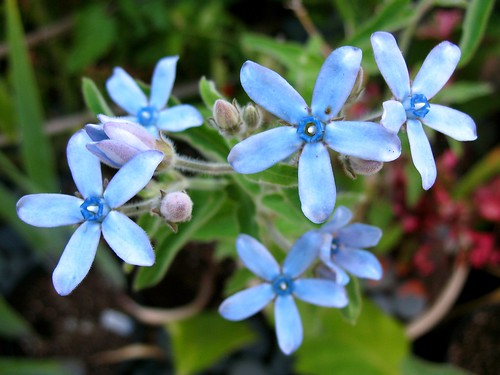
One Sunday in May TheGardenLady was invited to lunch at Lacroix
Restaurant in the Rittenhouse Hotel on Rittenhouse Square. The restaurant advertises itself as having one of the 10 best hotel brunches in the US. TheGardenLady will not talk about the wonderful ambiance of the restaurant or the fantastic service we had that day nor the marvelous food both in the presentation and taste. It was an amazing experience that
TheGardenLady was happy to have once in her life. Still as nice as all that was, that is not what made TheGardenLady want to write about the experience. TheGardenLady is interested in plants. And on the table were some unusual floral pieces that I think warrant a post.

First decorating the table was a cache pot filled with fraises du bois ( I have seen it also written fraises des bois). Fraises des Bois is translated as strawberries of the woods or wild strawberries. Growing up in the country, TheGardenLady couldn’t wait for spring and early summer to look for wild strawberries, the native American wild strawberry, Fragaria vesca var. americana, which grows in spring in the fields or in patches along the roadside or near the woods of the eastern states. These wild strawberries were tiny and delicate with an intense strawberry flavor. They were ambrosial.
TheGardenLady thinks her mind doesn’t deceive her when she recalls finding some in the Black Forest in Germany.
Then when TheGardenLady moved to the town where she presently lives,
she found there were patches where the wild strawberries grew. This was so wonderful and she delighted finding berries in these spots she kept secret. But then the street crews mowed the green along the sides of the road, mowed the areas where the strawberries grew. And they mowed so often that these wild patches gave up the ghost. The strawberry patches are no longer alive.
Several varieties of this wild berry have been growing in forests all over the world since prehistoric times, and though I once read that the French have domesticated them, I have never tasted the domesticated wild strawberry; but have been told that even the French have never succeeded in breeding a strawberry that compares to its wild cousin when it comes to taste.
Like TheGardenLady, the French are particularly fond of wild strawberries. From June through September, I have read that there are platters full of the deep red berries in restaurants lucky enough to have a supply. And even in France, the best way to enjoy this treat is à la nature, plain.
As charming as the pots of wild strawberries were, it was the vase with two plants that TheGardenLady had never seen before nor had anyone else at the table that was so interesting. This arrangement was most intriquing. The first plant in the vase had flowers that were sky blue with 5 petals like a little star, even having some of the flowers seeming to be changing into pink. The flowers looked something like forget me nots or pulmonaria but were at least 4 times larger than those flowers. And the leaves of the plant were different in that they were velvety.
The other flower in the vase was just green, the size of a golf ball of spear-shaped, slightly curled leaves. It almost looked like a thistle, but it was soft. These plants in the vase were puzzlers. So the maître d’ (Tory) said he would call to ask the florist and email me the names of the plants.
Even when the restaurant sent the names of the plants, TheGardenLady and her horticultural friends had still never heard of these plants.

The blue flowered plant is called a Tweedia – (Tweedia caerulea). This plant,
which was introduced from Brazil and Uruguay a few years ago, grows as a vine or what is called a subshrub and can grow up to about 3 feet high as a perennial in zones 6 thru 9 or as an annual in cooler areas. Tweedia plants attract hummingbirds, butterflies, bees and other nectar drinkers. The plants are drought tolerant and can be wintered indoors as houseplants. The flowers can last in arrangements longer than most flowers, up to 10 days. And they have interesting boat-shaped green seedpods, which can be used in dried designs, further extending these flowers’ value and versatility. Though the computer says there are sites to buy seeds of Tweedia, the sites
selling them in the US seemed to be out of the seeds.
The second plant was a dianthus, newly introduced this year and a winner of numerous awards in the US and abroad. Its entire name is Dianthus barbatus Green Trick ‘Temarisou’ They say that this flower that blooms from April to October is really usable as a cut flower, keeping for 4 weeks in a vase. Here is the dianthus information.
Though TheGardenLady has seen other Dianthus barbatus for sale, where one can buy barbatus Green Trick ‘Temarisou’ to plant in the garden or even where one can find any horticultural information about this unusual plant is something she would like to learn. If any reader knows anything about this plant, please write to TheGardenLady.org to let us know. It looks like it would be a nice addition to a garden.


I have Tweedia Caerulea, it seeds readily and is a nice addition with it’s blue flowers. I came upon a Green Trick ‘Temarisou’ as cut flowers and am searching for information on seeds or plants. What a find! Rose Germaine